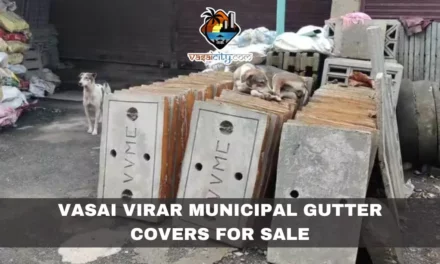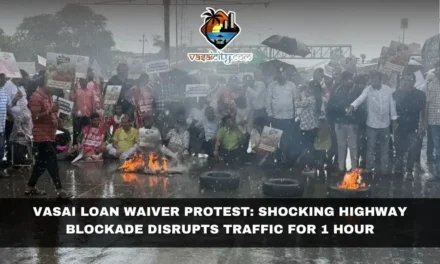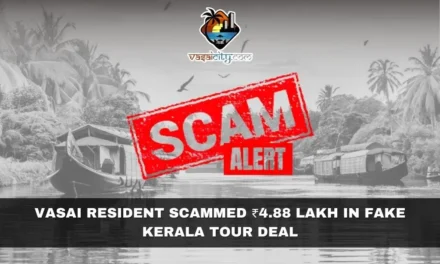Arnala Fort village, located off the coast of Virar West in Maharashtra, is known for its scenic surroundings and historical significance. But for the people living here, especially during the monsoon, life is anything but calm. The village sits on an island, and residents depend on boats for their daily commute. This geographical isolation makes them more vulnerable to nature’s fury, especially during heavy rains and strong winds.
This vulnerability turned into reality on Friday evening when a sudden storm swept through the area. Within just 5 to 10 minutes, violent winds tore off the roofs of at least 7 to 8 homes, leaving behind broken homes and shaken families. The storm didn’t last long, but its impact was intense and frightening.
An Unexpected Storm
The weather over the past few days in the Vasai-Virar region had been unstable. Strong rains, coupled with gusty winds, have been a regular occurrence. The regional weather department in Mumbai had already issued a warning about the possibility of thunderstorms and strong winds for the next few days.
But residents say they were still not fully prepared for what came their way that evening.
“We heard the winds picking up speed, and within minutes, our roofs started flying off,” said one local resident whose home was badly damaged. “The storm didn’t even last ten minutes, but it destroyed everything. We’ve lost more than just a roof – we’ve lost our sense of safety.”
Another resident described how metal sheets from rooftops flew across homes and landed on neighboring houses, causing further damage. “There was no time to react. We just held onto our children and prayed it would stop,” he said.
A Coastal Life Full of Struggles
Arnala Fort village is home to many fishermen and their families. Every day, they battle the sea for their livelihood. Being on an island, everything from travel to access to basic services is a challenge, especially during the monsoon season. And when nature lashes out, these challenges turn into life-threatening crises.
During the monsoon, heavy rains flood paths, and high tides batter the shores. In such conditions, a small fishing village with modest homes made of tin and wood is always at risk.
“The sea is never calm during the monsoon, and the winds are always strong,” said a fisherman. “But Friday’s storm was different. It came too suddenly and too powerfully.”
The storm didn’t just damage homes. A large flagpole near the village temple was also bent due to the high-speed winds, and waves crashed violently against the coast, further increasing the fear of more damage to come.
Social Worker Calls for Government Action
Social worker Ninad Patil, who visited the area soon after the storm, has called for urgent action by the local authorities. He is demanding a proper survey (panchanama) of the damage and compensation for affected families.
“These families are already living hand-to-mouth. They can’t afford to repair their homes every time nature strikes. It’s time the government steps in and helps them with immediate financial support,” Patil said.
He also stressed the need for stronger housing structures in coastal villages and better preparedness when weather warnings are issued.
When the Weather Forecast Brings Fear
For the people of Arnala Fort village, a storm warning is not just a bulletin on the news — it’s a signal to prepare for the worst. Residents say that as soon as they hear of bad weather, fear sets in.
“Every time we hear a weather alert, we worry. Will our homes survive the next storm? Will we be safe?” asked one woman, whose family of five had to seek shelter in a neighbor’s house after their roof was blown off.
The fear isn’t new. Over the years, the coastal belt around Virar has faced several instances of heavy damage due to storms. Each time, the residents rebuild — sometimes with help, but often on their own.
They are resilient, but that resilience is born out of necessity. “We don’t have a choice. We rebuild because we must. But it’s not easy. And it’s definitely not fair,” said a young man from the village.
A Call for Long-Term Solutions
The incident has once again highlighted the urgent need for long-term planning for such vulnerable communities. It’s not just about temporary shelters or quick repairs. Experts suggest that better coastal infrastructure, stronger housing materials, and emergency shelters should be part of a sustainable plan for villages like Arnala Fort.
Moreover, better communication of weather alerts and faster response by local authorities can make a huge difference. In such island villages, even small delays can cost lives and livelihoods.
Looking Ahead
As of now, the weather department has continued to issue alerts for more rain and wind in the coming days. For the people of Arnala Fort, the nightmare might not be over just yet. But they hope that this time, their voices will be heard, and help will arrive before the next storm does.
Until then, they wait, repair, and carry on — because for them, survival is a daily reality, not a choice.








